Wheathampstead Church, St Helen's, Hertfordshire - Monuments
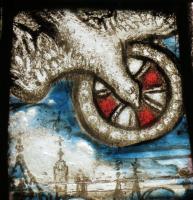
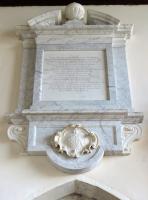
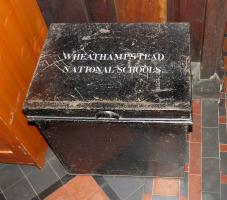
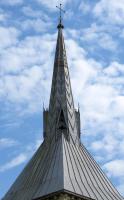

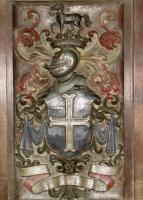
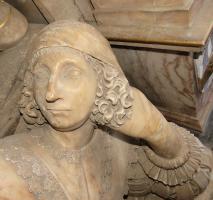
St Helen’s Church, Wheathampstead, is most distinguished by its spiky steeple, with the roof shallower at the base,
then sharply vertical, or almost so above – called a broach spire; it is placed on a short tower that is placed centrally
on the Church, beneath is a nave with wide transepts so that it appears effectively cruciform from many viewpoints,
though it is not. Built of flint with stone dressings, the different parts of the Church date from the 13th Century
through to the 19th, with the tower itself being of the late 13th Century with a Victorian rebuild of the spire.
Inside, the Church is broad, with nave, aisles, vestry and two porches. The dates are mixed,
the evolution of the Church being described as gradual and continuous, and what we see today is an interesting
and explorable space of pillars and arches, unified by Victorian makeovers which added fine tiling, a degree of restoration,
and the repainting of the splendid chancel ceiling.
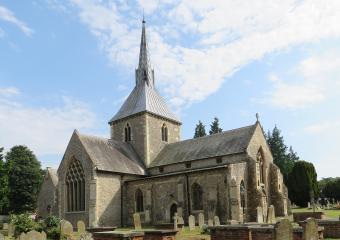
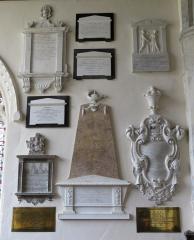
Wheathampstead Church, St Helen's.
Monuments
There are two grand monuments with reclining figures, and a dozen and a half panels, some with sculptural decoration.
We start with the two recliners, of the 16th and 17th Centuries, and epitomise two rather different styles,
The earlier one is to Sir John Brocket and Dame Margaret, his wife, with his date of death being 1558.
The pair of figures lie side by side on an altar tomb, and represent late examples of a long tradition of
medieval monuments of this type, the stone figures gradually becoming more lifelike, as here, but still mannered
and conventional in their praying pose. What a contrast to the later monument,
to Sir John Garrard, d.ca.1637, and his wife Lady Elizabeth, and Isabella Garrard.
Here the figures of Sir John and Lady Elizabeth are turned on their sides, leaning on their elbows.
There is still a stiffness, and odd touches – the drapery, however skilful, falls down Lady Elizabeth’s
legs rather than vertically down towards the floor – but there is a liveliness too. Each figure has their hips angled,
to allow the upper leg to swing backwards and rest more easily; Sir John has one elegant hand on his sword,
whose tip rests conveniently over his ankle; and Lady Elizabeth holds a book, as if she has just stopped reading.
The details are finer, richer, and there is a sense of swagger to the monument missing from the earlier piece.
Sir John Brockett, d.1558, and wife Dame Margaret
Sir John Brockett, d.1558, and wife Dame Margaret [Benstede] Brockett. A great altar tomb, with a pair of
life size effigies on top, lying back supported with their hands in prayer. Around three of the sides of the altar tomb
are panels with figures; the side behind the effigies’ feet is against the wall. Sir John wears full plate armour,
and has two necklaces or chain. His face is gaunt, deep sunk eyes in rounded sockets, a thin nose, haggard cheeks,
and a beard, damaged, which emphasises the length of his face. He is bare-headed, his helmet being his pillow,
and his hair is quite long at the back, monklike at the top over a rounded forehead. We can see the remnants of a sword
by his side, and his armoured feet rest on a small lion. Though there is some damage to the figure’s face and hands,
Sir John’s armour remains in extremely good preservation over 450 years on.
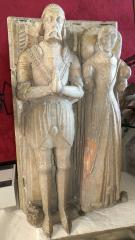
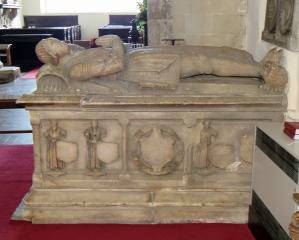
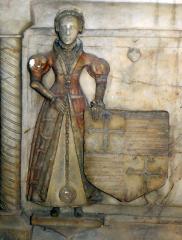
Sir John Brockett and Dame Margaret Brockette, mid-16th Century.
Dame Margaret is in poorer state, with damage to the head, and arms broken above the elbows. Her face looks old,
made more so by her skullcap, but we still see some femininity around the mouth and above it, and in the curve of the chin.
Her head rests on two tasselled pillows. She wears a long, light robe, caught at the waist by a broach, otherwise open,
under which her shirt has a wide, soft collar, with two ties at the front; the sleeves are puffed out at the top.
She wears longs skirts down to her feet, damaged again and resting on the remnants of some ruined beast,
and under her is a an outer cloak caught at the shoulders. Battered as the figure is, the viewer is struck
by the slenderness of her waist and curve of her body, a slight figure indeed next to her husband,
though not much less tall. Set on the wall behind the figures is an alabaster plaque bearing two shields of arms
in separate panels separated by small pillars with spiralling grooves, and a shelf above.
The small figures on the sides of the tomb are also worth study. There are eight in all, each standing and holding
a heraldic shield. The two on the short side are miniature versions of the statue of Sir John, with the same
style of armour, two chains round the neck, and a long sword by the side (picture below). On the south side, that is to the side
of Sir John above, are three more standing men, robed rather than with armour, two together, one apart,
really rather damaged. To Dame Margaret’s side, northwards, are three more statuettes, this time female
and dressed rather like her, with the same open outer garment and puffed sleeves, and in a better state of preservation
than the other small figures - one is shown above right. They wear some sort of headgear, or tightly curled locks, and this may be what
Dame Margaret originally had on her head.
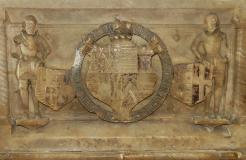
Sir John Garrard, Lady Elizabeth, and Isabella Garrard
Sir John Garrard, d.ca.1637, his wife Lady Elizabeth Garrard, and Isabella Garrard, d.1677.
A grand monument against the wall, centred on the figures of Sir John and Lady Elizabeth, he behind,
she in front lying a little lower so that both figures can be seen. Above them is a vast alabaster canopy
held up on dark-shafted marble pillars to the sides, with a central arch over the figures and containing
the lengthy inscription. Above this, a heavy entablature decorated with shields of arms, and a large, baroque pediment,
broken in the centre, curved and raised, with further figure sculpture and heraldic devices. Below the main figures
on the front of the sideboard like structure underneath, kneel the ranked children of the couple, 14 in all.
As noted above, the figures lie on their sides, and there is a compositional relationship between them –
their poses are very similar, giving a harmoniousness to the couple, and her gaze is upwards, his forwards,
as if they are in conversation. The two statues are almost identical in length, but we can contrast
her more shapely figure with his more powerful masculine one, and her soft and richly decorated clothing
with his stiff armour.
Beneath, the small figures of their children are more conventional kneelers, each boy similar to his brothers,
differing only in size, and all the girls with sisterly similarity, and almost identical pose, showing a gradual aging
from the plump infant in front – she died an infant, for she carries a skull – to the lengthening faces, more abrupt noses,
more solid necks and more receding hairlines of the older girls.
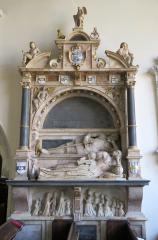
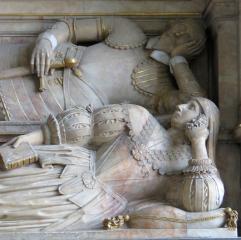
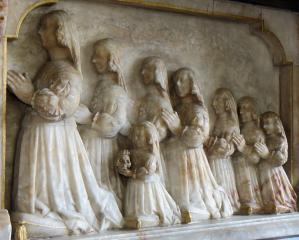
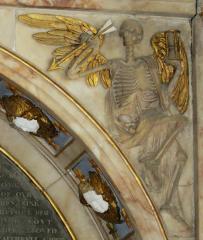
Sir John and Lady Elizabeth Garrard, 17th Century.
The other figure sculpture is good too: in the spandrels (triangles above the arches) are alto relievo figures
of a female angel with nice drapery, and a grinning winged skeleton with arrow and hourglass.
On the edges of the pediment are seated putti, plump and naked, and at the very summit is an allegorical figure of Time, old,
bearded and winged. Monuments do not come much grander than this.
Other monuments
- John Heyworth, d.1558, and his wife Joane, the monument being erected on the instruction of
their adopted daughter Margarett Hoo, whose second husband, Nicholas Brokett is also commemorated, by the latter’s
son John. Above the epitaph is an inscribed picture showing the kneeling couple, facing each other
in the conventional way across a small desk or faldstool, with behind them their three children,
who died in infancy – boys behind the father, girl behind the mother (see picture below, click to enlarge). The composition is similar to that of many monuments
in the round of the period and through until the early 17th Century, a significant difference being that the figures
all face somewhat towards the viewer, rather than directly towards each other. The slightly battered frame has on top of it
a small shield of arms with a knight’s helm carved on top, with generous mantling,
all within a circle which is the remnant of some strapwork decoration. Underneath the lower shelf, two meagre supports
and a central cut apron with a small central flower and further simple strapwork designs.
I have not seen such an inscribed picture as this from this period before. It is perfectly, preserved,
as is the inscription, unlike the surround, and I wonder – entirely ignorantly – if it might have been copied in stone
from an original brass at some much later date.
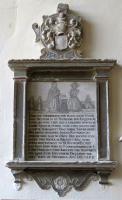
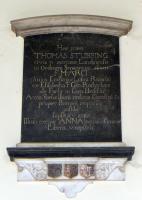
Heyworth and Stubbings monuments.
- Nicholas Bristow, d.1584, listing the monarchs he served under and various of his family.
Plain black panel with a thin stone shelf above and two brackets.
- Thomas Stubbing, and Marci [?] and Anna, with
a Latin inscription. White on a black backing, with a curved shelf above, a shelf below, and below that,
three small shields of arms with curly side pieces, carved as acanthus leaves, on white marble.
Stubbing was a landowner in Wheathampstead from 1638 at least into the 1640s, so we can guess the panel dates
from the second half of the 17th Century.
- Sir John Garrard, Baronet, d.1686, and wife Dame Jane [Lambard], d.1692,
noting they had 23 children, of whom 17 survived their father. White marble Classical panel, with fluted side pilasters,
shelves above and below, and on top, a cartouche of arms, painted, on a curly base, with a conch shell on either side.
Below the lower shelf is a heavy, curved bracket on each side with a corbel at the base carved with Acanthus leaves;
in the centre is an apron with a fluted jelly-mould terminus.
- Sir John Garrard, Baronet, d.1700, noting he was of ‘Lamer in the County of Hertford’ –
the first mention of this large estate near Wheathampstead, the seat of the family thereafter.
White Classical panel with fluted side pilasters, entablature and above, as for his father’s monument noted above,
a pair of conch shells, but here flanking a carved urn, with a small flame at the top. At the base of the monument
is a gadrooned (corrugated) shelf, held up by curvy side brackets with a central apron with the painted cartouche of arms
enclosed by low relief palm fronds. At the very bottom, a central winged cherub head. See picture below left.
The monument is signed by Robert Taylor, a significant sculptor of the 18th Century (another, grander monument by him in Hertfordshire is
shown on the page about Hunsdon Church).
The inscription on the panel notes that Sir John married Dame Katherine,
a co-heir and daughter of St James Enyon of Northampton, and that their single offspring,
Jane, married Mountagu Drake of Shardelois in Buckinghamshire – their splendid monument is in Amersham,
and includes relief portraits of both of them.
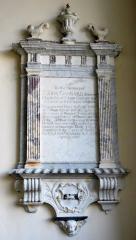
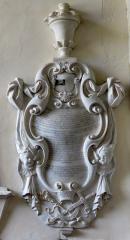
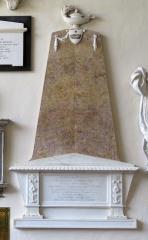
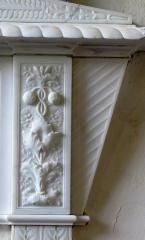
Baronets of the Garrard family, 18th Century.
- Sir Samuel Garrard, Baronet, d.1724. He was Lord Mayor of London in 1710,
an MP for the Borough of Agmondesham, Bucks, etc. His second wife, Jane (Bennet) Garrard, erected the monument.
A pure white marble cartouche, with violin-shaped centre, and a surround of symmetrical scrolls and drapery,
knotted at the top to the sides, and enclosing two winged cherub heads part way down. Above the inscription
is a mini-cartouche with painted shield of arms, and on top, a small pot with gadrooned sides.
At the base, crossed sword and sceptre and a motto, carved in high relief. See picture above.
- Margaret [Gay] Garrard, d.1765, with a eulogy. Classical panel of black veined white marble,
with receding sides, upper curved pediment broken in the centre to admit a round pot. Below the lower shelf,
a heavy apron with central cartouche, quite ornate and carved in a much whiter stone, with a low relief shield of arms
in front of a lion; to the sides are scrolly side-pieces in the same white marble. See picture at top of page, second from left.
- Sir Bennet Garrard, Baronet, d.1767, son of Sir Samuel Garrard, d.1724 noted above.
A tall obelisk monument. The obelisk, tall and broad, is made of a pinky brown marble,
and has at the top a small flaming lamp, Aladdin style, above a small painted shield of arms with small drapes
to the sides, one of which has lost a piece. The height and breadth of the space below suggests
that there may have been some further sculpture on it, though no holes are visible.
The lower part fot he monument is a conventional casket-end panel, with outward sloping sides,
gadrooned lid, solid feet, and above these, pilasters bearing delicate low relief carvings of poppy plants - see pictures above, right.
- The Revd. John Wheeldon, d.1800, and three of his children. He was Rector of the Parish
for 27 years, and Prebendary of Lincoln. White panel with the thinnest of borders, an upper shelf,
and supported on two brackets carved with stylised leaves.
- Thomas Hawkins, d.1804, who married a great grand-daughter of Sir John Garrard, Bt –
the one with 25 children noted above. An oval white panel on a dark and light grey backing panel,
mostly rectangular but cut with a part-circle curve to the base, on which is a broken, painted shield of arms,
and beneath, a blocky support, signed by the stone mason, difficult to read, but I think T. King of Bath.
Thomas King and Sons of Bath produced many monuments from about 1760 through to the 1820s,
and their work can be found across southern England, and a few elsewhere.
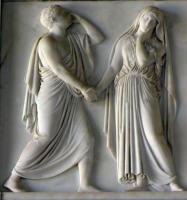 Thorwaldsen's sculpture for Charles and Ann Garrard.
Thorwaldsen's sculpture for Charles and Ann Garrard.
- Charles Drake Garrard, d.1817, and his wife Ann [Barne] Garrard, d.1827.
Panel with relief sculpture within a Classical surround with pilasters and a curved pediment above,
on which is carved a butterfly in low relief. We see a Grecian couple, she standing, head in hand,
he clasping her hand and with his other arm raised and to his head, the attitudes of both figures
suggesting surprise and grief. The beauty of the piece is in the Classical drapery, simply cut,
with repeating folds and stretched across the thighs to outline the legs.
This understated piece is signed by the famous Danish sculptor Bertel Thorwaldsen.
He was hugely influential on a generation of English Classical sculptors, but there are not so many works
by him in Britain, so a pleasure to see this.
- The Sibley sisters: Jane Sibley, d.1826, Sophia Sibley, d.1841, and Martha Sibley, d.1850, all rather long lived.
Panel with upper shelf and lid, on a shaped black backing, a modest piece signed by the obscure Warren of Hitchin.
A small black floor panel notes Jane Sibley, d.1826, and Sophia Sibley, d.1844
– they were in their 80s and 90s too.
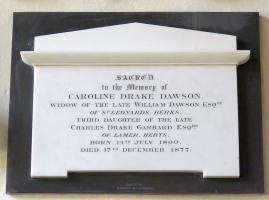
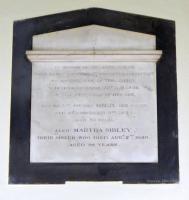
Black and white panels, by Gaffin, and by Warren of Hitchin.
- Three panels to daughters of Charles Drake Garrard, and his wife Anne:
Anne Garrard, d.1862, 1st daughter, Caroline Drake Dawson, d.1877, 3rd daughter,
and Louisa Garrard, d.1826, 4th daughter. All are white panels cut with feet and a lid,
and with a narrow shelf near the top, on a black backing, and signed by Gaffin of Regent Street,
most prolific of panel makers of the white-on-black style. It was a family business, and the panel to Caroline
is signed specifically by T. (Thomas) Gaffin.
- Major Robert Dymond Cladman Sibley, d.1918. Earlier Sibleys are noted above.
Cut with little feet, an upper lid, and with a small shelf on which is a very small RAF insignia.
On a shaped black backing panel. Rather hankering back to the white on black panels of the previous century,
except that the white marble chosen is heavily streaked with grey.
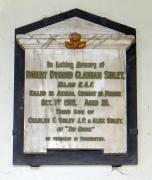
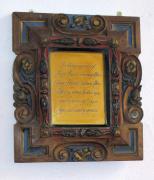 World War I panels: Major Sibley, and the Allen brothers.
World War I panels: Major Sibley, and the Allen brothers.
- Lieut. Francis Edward Allen, and Gunner Harold Sydney Allen, d.1918, killed in WW1.
Brass panel with a rather excellent wooden surround, heavily cut almost in 17th Century style, and coloured in red,
blue and gilt – a late Arts and Crafts work of merit.
- Apsley George Bent Cherry-Garrard, d.1959, Antarctic explorer with Scott.
Plain stone panel underneath a small statue of him, standing in full polar gear – padded jacket, huge mittens,
floppy trousers and boots. In a modern idiom, with attention given to the face and everything else a bit sketchy.
Cherry-Gerrard took the double-barrelled surname as a condition to inherit the vast Lamer Park estate,
previously owned by the Drake-Garrard family.
- Patrick Ogden, d.1968, modern panel in wood.
Modern brasses
- Charlotte (Garrard) Cherry, d.1880. Typical revival brass panel, with the inscription
in black capitals with red initials, and an inscribed border of repeating leaf shapes,
mostly black with coloured highlights.
- Honora (Duncombe) Garrard, d.1892, similar in style and a little less ornate
than the Cherry panel noted above.
- The Lieut. Allen monument is noted above, as the brass panel has a carved wooden surround.
- Matthew Edmund Smallwood, d.1951, and sons David Lovell and Patrick Lovell,
who died in World War II. Plain brass panel.
Also in the Church
- An ancient Reredos, under the east window of the North Transept,
discovered in the Victorian renovation of the Church. It dates from 1330-1340, and was much admired by Pevsner, the architectural historian.
We see seven trefoil blind windows, or niches, with empty pedestals within them, and above,
a remarkable assemplage of carved leaves and flowers, with the face of one beastling peering from one of the spandrels.
The arch on the far right is incomplete in its carving.
- A piscina, medieval, donated it is believed by the Macry family.

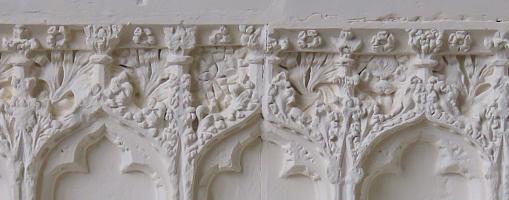
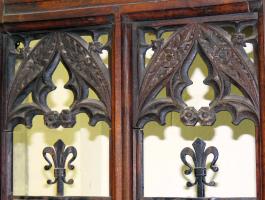

Ancient font, reredos, sample woodwork, and carved ceiling bracket.
- The ancient and battered Font, early 14th Century in date, with the dark granite bowl
set in an octagonal surround of white stone, resting on a somewhat darker solid shaft with attached pillars
at each of the eight corners. Around the outside are quatrefoils, heavily carved, and on the shaft are fleurs de lys,
and the base, raised on two steps, has medieval clay tiles set within it.
- A few black floor slabs, 17th and 18th Century, including with shields of arms.
- The panelled and brightly painted barrel shaped ceiling of the chancel.
With carved bosses, and a variety of quatrefoil designs in light blue, red, white and black.
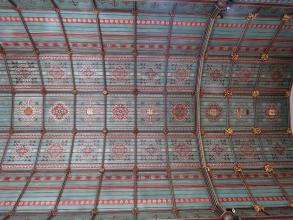
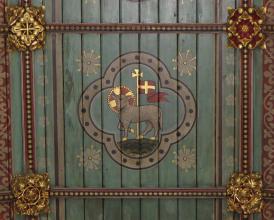
Wheathampstead Church chancel ceiling, and detail.
- A wooden screen decorated with shields of arms and tracery at the top,
with carved symbols of the countries of the UK (thistle for Scotland etc) at the tops of the narrow window lights.
This Jacobean piece, and various other items of woodwork, including the old pewing and perhaps gallery rails,
apparently came from Lamer Park chapel which was demolished in 1761.
- A Royal coat of arms, painted and heavily gilt, and a painted hatchment.
- A nice metal box from Wheathampstead National Schools (see picture at top of page).
- Brackets supporting the roof beams bearing carving of farming schemes etc,
each with a small figure, rather over-painted and high up to see much fine detail.
- Stained glass windows of high quality, including a rather Symbolist piece of 1905.
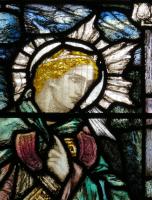
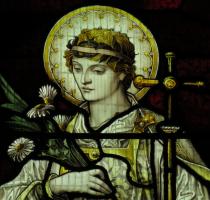
Outside the Church
St Helen’s Wheathampstead stands surrounded by its churchyard, giving impressive views of the structure from
different aspects. There are the usual different types of headstones, and a goodly number of tomb chests,
raised ledgers and the like, a few surrounded by iron railings. On one side is a tall cross in stone,
with a bronze sword, downward pointing, upon it, and a small wreath, which is the Wheathampstead War Memorial.
There is also a notable lich gate, a handsome bit of late 19th Century wood and tiling, restored for the Golden Jubilee.
With many thanks to the Church authorities for kind permission to use pictures from inside the Church;
see the Church website at http://sth-stp.org/church-history/.
Top of page
Also in Hertfordshire: monuments in other Hertfordshire churches, including Aldenham Church, Tring Church, Aldbury Church and Abbots Langley Church
Hertford War Memorial // Cheslyn Gardens statue, Watford
Introduction to church monuments // Angel statues // Cherub sculpture
Sculpture in some towns in England
Home
Visits to this page from 14 Oct 2016: 6,843





















